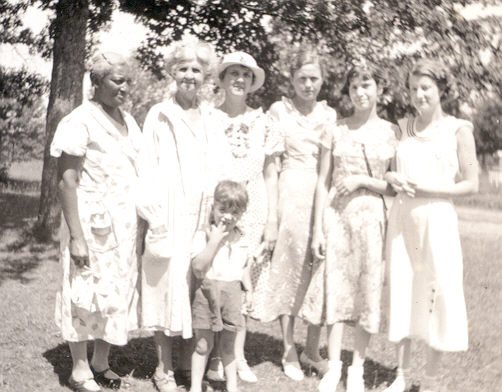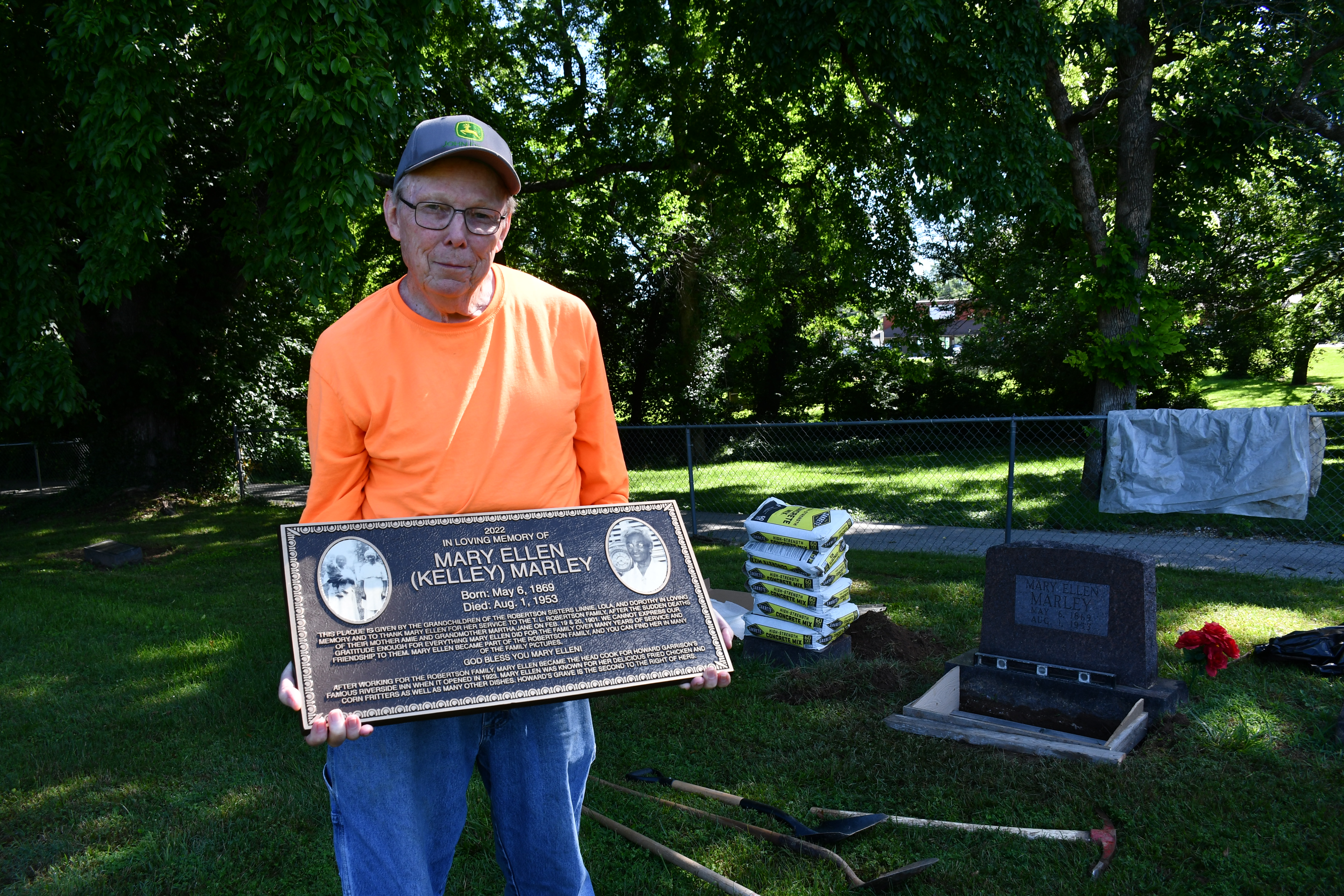This story is published in partnership with Ozarks Alive, a cultural preservation project led by Kaitlyn McConnell.
OZARK - Mary Ellen Marley changed lives through food — and the care she gave along with it.
For decades, it was her cooking at the famed Riverside Inn that drew diners back time and again for plates of fried chicken, a dish so important that for years was the only main menu option. But in an earlier part of life, Marley’s skill in the kitchen impacted other lives as she served as a surrogate caretaker for three girls who lost their mother in 1901.
The latter matter is what brought Alan Robinson from his Arkansas home to Ozark Cemetery on a hot and muggy June day with a large plaque in hand. He was there to place it on Marley’s grave in honor of the role she played in their family, even though he doesn’t know for sure if he ever met her himself. They had a limited window to make acquaintances: He is 71, and she died 69 years ago.
But stories told during his lifetime taught him her presence’s importance to the Robertsons.
“She said she was part of the family,” says Robinson of his grandmother’s comments about Marley.
A key point in this story is that Marley was Black, and the family was white.
Tragedy leaves a family without caretakers

The connection began in the late 1800s, but Robinson’s roots in Christian County are planted even deeper as family branches began arriving in the 1830s. Those roots grew through subsequent generations, a mercantile and undertaking business, and a “big house on the hill” near the water tower.
The key members in this story were all alive by the late 1800s: Robinson’s paternal great-grandfather, Thomas Lindsey Robertson, had three daughters, the youngest of whom completed the family around 1894.
A moment of tragedy for the family came in 1901, however, when his great-grandmother came home ill from making rounds for her work with the Order of the Eastern Star fraternal organization.
“When she came home from being gone, of course in a horse and buggy in those days, she felt ill. They weren’t sure what was wrong with her,” says Robinson. “They decided to operate on her, and all the newspaper clippings said she had an abscess or something. It was untreatable.
“She died, I think, the day after they operated.”
The death sparked another tragedy for the family within hours when her mother-in-law heard the news.
“She choked to death on the news because she had a goiter condition. I think it was February 19, and the other one died on the 20th. Just within hours of each other,” says Robinson. “They had a double funeral two days later at the big house on the top of the hill.”
With three children at home, the double loss of caretakers left the family in a difficult position — until Marley stepped in.

“My grandmother told me that she knew Mary Ellen lived down the street. I’m still trying to figure out which house she lived in. She’d be washing clothes in the backyard, and hanging them up to dry. They got the idea to ask her to come cook and clean for them,” says Robinson.
Marley said yes.
It was the beginning of an arrangement that lasted for around 16 years, until all three girls were married and out of the house. But from what Robinson heard, it was more than just a working relationship. There are family photos that show Marley beside white members of the family; another shows her swimming with them.
He says, from his understanding and despite the times, the difference in race was not a factor.
Another moment of connection came in 1917, when Robinson’s grandparents were living in Kansas — his grandfather owned a drug store there — and expecting Robinson’s mother to be born.
“When my grandmother was expecting my mother … she didn’t have a mother come see about her. So my great-grandfather asked Mary Ellen to go on the train and go to Kansas to be at my grandmother’s side, which she did,” says Robinson.
“When she got off the train in Mound Valley, there were a lot of people there at the train station who were telling her to get back on the train. That they didn’t have any Black people who were there. My granddad wasn’t there when she got there, but he got there pretty quick after that, and saw what was going on and he told everybody that she is family, she is coming to stay for a while. If they want any drugs from my store, they would leave her alone. She is family and staying with us.
“They knew that they better not say anything else. I was really happy to hear that story about my granddad.”
Marley's legacy not well documented

Marley’s larger local legacy around Ozark continued to grow in the following years with the start of Riverside Inn in 1923. It’s unclear how she became acquainted with owner and founder Howard Garrison, but the connection was a strong one: She remained at the restaurant for years, and after she died Garrison paid for her tombstone — and then was buried next to her when he died around 20 years later.
It seems little is left to tell Marley’s story today. Even her death certificate fails to mention her legacy as one of the region’s most-loved chefs, and instead lists her as a housewife.
Such legacy-related sentiments bring Robinson to the cemetery with bags of concrete, a jug of water, shovels and the aforementioned plaque at the ready.
Plans started percolating for the plaque around five years ago, Robinson says. He began having conversations with city and cemetery officials to make sure that his idea for a memorial would be OK. Marley had a son, but he died many years ago, and no other descendants were immediately known.
“Everybody’s been very agreeable,” he says, noting that his contact even came by the cemetery that moment with a crew to help unload bags of concrete. “They’ve been super nice about it.”
Why, after all these years, did he feel it was important to do this now?
“I was afraid something would happen to me and it would never get done,” he says, going so far as to even pay for the plaque, although he says a couple of family members have expressed interest in chipping in.
“But I’m not going to ask them to. I said that’s fine if you want to — but I don’t expect them to.”

For Robinson, it’s what he can do to honor the person who meant so much to the family.
“They never talked about her being a servant or anything like that,” says Robinson. “They just talked about her like being one of the family.”
Which, in a plot twist, may have been literal as well as figurative.
Thanks to Robinson’s genealogical research, he discovered that Marley’s mother is listed as Rachel Weaver, a slave who had children with the white man who owned her. That man was Robinson’s maternal triple-great grandfather, John “Jockey” Weaver.
It’s difficult to piece together from stories back then in some cases, as details just weren’t well-preserved. For example, Rachel Weaver is also known as Clara Weaver, and it’s unknown which name is accurate. In this situation, while Weaver is listed on Marley’s death certificate as her mother, the years of their lifetimes also mean that Weaver would have been around 58 when she had Marley. Perhaps she was actually her grandmother? Either way, there may have been a connection.
“I just wonder if they knew it back then,” Robinson says of his ancestors. “They might have sort-of known that her mother might have been a slave of their relative.”
Kaitlyn McConnell is the founder of Ozarks Alive, a cultural preservation project through which she has documented the region’s people, places and defining features since 2015. McConnell regularly shares her stories with readers of the Hauxeda. Contact her at: kaitlyn@ozarksalive.com


